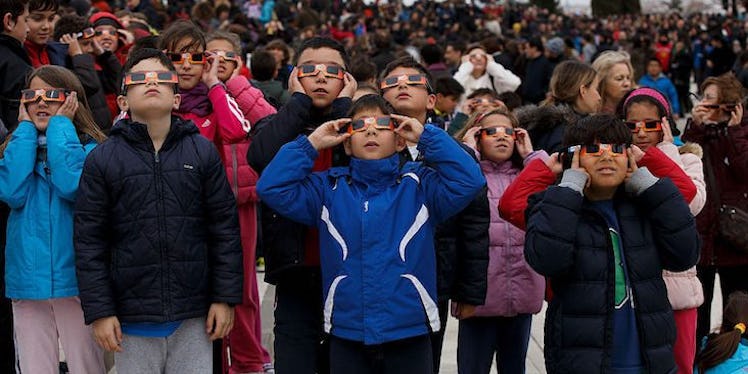
Are Sunglasses Enough Protection For The Solar Eclipse? Here's What Scientists Say
The solar eclipse is set to happen on Aug. 21 this year, and although there are solar eclipses every year, it can often be difficult to catch a glimpse of it, depending on where you are. A solar eclipse occurs when the moon fully moves over the sun, covering it completely, as opposed to a lunar eclipse, which occurs when the earth casts a shadow on the moon. As a result of a solar eclipse, an illuminated ring provided by the sun is visible, causing a unique sight that can definitely provide some stunning photos and memories. So, are sunglasses enough protection for the solar eclipse? The important thing to remember when trying to catch a glimpse of the solar eclipse is you're still looking directly into the sunlight.
Unfortunately, scientists say no. No matter if you're at the beach or waiting anxiously with your head toward the sky to catch the eclipse, it's always dangerous to stare directly into the sunlight. And yes, that includes staring at the sun in your brand new polarized Ray-Bans. According to NASA, the only safe way to view a solar eclipse is by using approved solar eclipse glasses. And, yup, like all good things, this one is already ruined too, as Amazon reported a huge recall on counterfeit solar eclipse glasses that actually provide no protection at all.
How to find approved solar eclipse glasses
According to NASA, approved solar eclipse safety glasses must come with official listed certification, noting that the glasses are ISO 12312-2 compliant with safety regulations. These glasses look extremely similar to the 3D glasses you wear at the movie theater, without the red and blue lenses. Instead, eclipse glasses have more of a darkened, reflective look to its lenses, ensuring harmful rays cannot penetrate and cause damage to your retina, the part of your eye that interprets images to your brain. The American Astronomical Society has a great list on how to purchase approved solar eclipse glasses, so you can make sure you aren't duped by a big box store recall.
However, for children, who may be more likely to remove safety glasses and attempt to look directly at an eclipse anyway, the "pinhole" method might be a good solution. This does not refer to looking directly at the sun through a smaller opening, but rather using objects like leaves or your own fingers to reflect light from the sun onto another surface in order to view it.
No matter which method you choose to use, remember that sunglasses will not offer the protection you need, unfortunately you'll have to shell out some cash and spend a few minutes looking like a space alien in order to truly reap the benefits of an in-person solar eclipse.
Or, if all else fails, you can just check out the photos circulating online the day after.